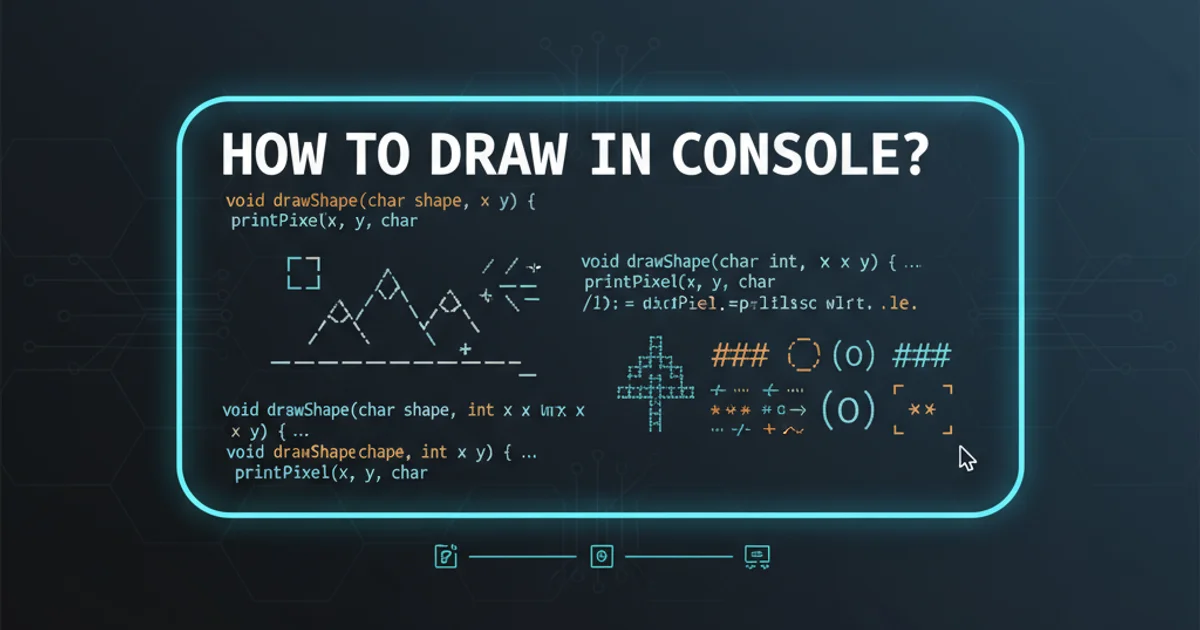How to draw in console?
Categories:
Drawing in the Console: A Guide to Text-Based Graphics

Explore techniques for creating visual output directly within the console using C# and VB.NET, from basic characters to more complex animations.
While modern applications often rely on rich graphical user interfaces, there are scenarios where drawing directly in the console can be useful, fun, or even necessary. This article will guide you through the fundamentals of console drawing in C# and VB.NET, covering character manipulation, color, and basic animation concepts. We'll explore how to position text, create simple shapes, and even simulate movement, all within the confines of a text-based environment.
Understanding the Console Grid
The console window can be thought of as a grid of characters. Each position on this grid is defined by a pair of coordinates: (X, Y). The X coordinate represents the column (horizontal position), and the Y coordinate represents the row (vertical position). The top-left corner of the console is typically (0, 0). By manipulating these coordinates and the characters printed at them, we can create visual patterns and shapes.
graph TD
A[Console Window] --> B(Grid of Characters)
B --> C{Coordinate System}
C --> D["X: Column (0 to Width-1)"]
C --> E["Y: Row (0 to Height-1)"]
D --& E --> F["Each (X,Y) holds one character"];Conceptual model of the console's character grid.
Basic Drawing Operations: Positioning and Characters
The core of console drawing involves setting the cursor position and then writing characters. Both C# and VB.NET provide methods within the Console class to achieve this. Console.SetCursorPosition(int left, int top) allows you to move the cursor, and Console.Write() or Console.WriteLine() are used to output text or characters at the current cursor position.
C# Example
Console.SetCursorPosition(10, 5); Console.Write("Hello, Console!");
Console.SetCursorPosition(12, 7); Console.ForegroundColor = ConsoleColor.Green; Console.Write("*"); Console.ResetColor();
VB.NET Example
Console.SetCursorPosition(10, 5) Console.Write("Hello, Console!")
Console.SetCursorPosition(12, 7) Console.ForegroundColor = ConsoleColor.Green Console.Write("*") Console.ResetColor()
Console.ForegroundColor and Console.BackgroundColor after changing them, especially if you want subsequent output to revert to default colors. This prevents unexpected color bleeding.Drawing Shapes and Lines
To draw shapes, you'll typically use loops to iterate through coordinates and print appropriate characters. For example, a horizontal line can be drawn by iterating through X coordinates at a fixed Y, and a vertical line by iterating through Y coordinates at a fixed X. Rectangles combine these concepts.
void DrawRectangle(int x, int y, int width, int height, char character)
{
// Top and bottom lines
for (int i = 0; i < width; i++)
{
Console.SetCursorPosition(x + i, y);
Console.Write(character);
Console.SetCursorPosition(x + i, y + height - 1);
Console.Write(character);
}
// Left and right lines
for (int i = 0; i < height; i++)
{
Console.SetCursorPosition(x, y + i);
Console.Write(character);
Console.SetCursorPosition(x + width - 1, y + i);
Console.Write(character);
}
}
C# method to draw a simple rectangle using a specified character.
(X, Y) coordinate within the shape's bounds and print the desired character. Using Unicode characters (e.g., block elements like '█' or '░') can significantly enhance the visual quality of console graphics.Simple Console Animation
Creating animation in the console involves repeatedly clearing a portion of the screen, drawing an object in a new position, and introducing a small delay. The Console.Clear() method can clear the entire screen, but for smoother animations, it's often better to only clear the area where the moving object was previously drawn. The Thread.Sleep() method (or Task.Delay() for async operations) can be used to control the animation speed.
Console.CursorVisible = false; // Hide the cursor
int x = 0;
int y = 5;
string character = "->";
for (int i = 0; i < 30; i++)
{
Console.SetCursorPosition(x, y);
Console.Write(new string(' ', character.Length)); // Clear previous position
x++; // Move right
Console.SetCursorPosition(x, y);
Console.Write(character); // Draw in new position
Thread.Sleep(100); // Pause for 100 milliseconds
}
Console.CursorVisible = true; // Show cursor again
C# example demonstrating a simple console animation of a moving string.
Console.Clear() can cause screen flickering. For smoother animations, try to only clear the specific area that needs to be redrawn. This is often done by overwriting the old character with a space character before drawing the new one.